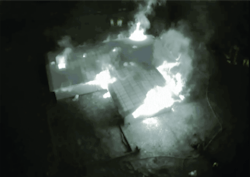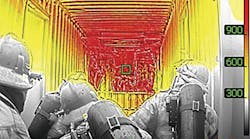Industry Insights: Aerial Firefighting Tech - Drones and Mountable Thermal Imagers
Editor's note: Industry Insights are sponsored blogs submitted by manufacturers and suppliers serving the fire service industry.
You’re likely familiar with handheld thermal imaging cameras (TICs), and maybe you even use one on the job. Handheld TICs have always been useful tools in every phase of firefighting, from when you first arrive at the fire scene until after the last ember is out. But the technology is quickly advancing, and now there are mounted and unmanned aircraft systems (UAS) aerial thermal imagers that offer a new perspective on the fire scene – from outside and above the fire.
Here’s how they can help you:
Fixed-mount TICs make targeting more effective
Fixed-mount cameras may do the most to improve firefighting efficiency. Whether they’re mounted on top of a truck or attached to a ladder bucket, these cameras provide an additional angle on the fire scene. A FLIR KF6 attached to an aerial apparatus can see through smoke billowing from a roof and show firefighters exactly where to direct the water spray. This is especially important in rural areas, where water may be a low-resource item.
The FLIR KF6 is the first mountable TIC specifically designed for aerial apparatus applications. It provides a high-angle thermal view of rooftops, upper stories, and other elevated structures, helping firefighting teams see clearly through smoke and total darkness from an additional strategic perspective.
- Industry Insights: High Temperature Ranges in TICs: Why Higher Isn't Always Better
Before going into a burning building, Green Bay, WI, Metro Fire Department uses TICs to assess the fire from outside. TICs provide the ability to view the scene from multiple angles which can help the incident commander direct resources more effectively. Regular visual updates from outside and above the fire can help the incident commander make better decisions about how to proceed. For instance, will the roof collapse at any moment? Is it safe enough to put guys on the roof or let them inside the building?
“Scanning the outside of a structure before we go in has become a standard procedure for us, because it can guide us exactly to where we need to be, to the target areas that are most affected,” says Brent Elliott, division chief at Green Bay Metro. “The thermal cameras allow you to scan an area very rapidly, which is of crucial importance. You can see just how much a scene is getting better, like if we’re making progress or if it’s getting worse and we need to think about getting our crews out.”
The FLIR KF6 can be easily and securely fixed-mounted under or atop aerial platforms and at the end of straight sticks. A single cable with a MIL-C connector provides 10-32 VDC in and composite video out for simple installation.
Drone thermal energy brings new capabilities to search and rescue
Thermal imaging drones could be crucial to quickly resolving search and rescue calls. Rather than waiting hours for a search helicopter, a rescue crew with a drone could begin looking almost immediately. They’re effective for tracking down trapped, stranded, and missing victims in water, or even locating a car accident victim who was ejected from the vehicle.
Firefighters in Green Bay already use thermal imagers when searching for hikers lost in thick grasses along the bay, but they’re at a disadvantage. “The problem we have with the phragmites grass is it’s so thick you have to be fairly close to catch the body heat of somebody. Whereas if you’re over the top of them with a drone, you could find them much more easily,” he explains.
Thermal imaging drones allow crews to fly a thermal imager over large commercial fires, hazardous material spills, brush fires, and more. A drone can allow a fire company to assess a dangerous area before entering, or search for hot spots after a brush fire.
“The more information you can have, especially for the incident commander, the better off you are,” says Green Bay Metro’s captain of Fire and EMS Training, Joseph Thomson. “If he can get regular visual updates from inside, outside, and above the fire, the incident commander can make better decisions about how to proceed. If they can see a picture from a drone so they can see the whole scene, and then room-by-room updates from the crew, that can only make things that much better.”








